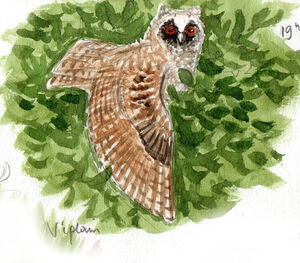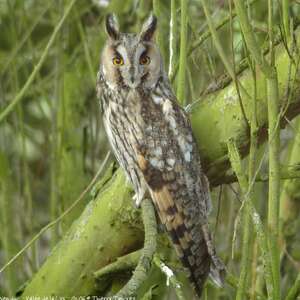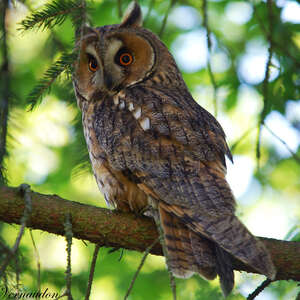Long-eared Owl
Asio otus - Hibou moyen-duc
Identification
The Long-eared Owl is a medium-sized owl (about 40 cm long with a wingspan of around one meter and a weight of 3-400 g). Its cryptically-colored plumage is nearly the same for both males and females, although the males are typically a bit paler than females and there is not a significant size difference between the sexes. The upperparts are a mixture of gray and chestnut with blackish vermiculations and are very well-camouflaged with the trunks and branches of its wooded habitat. The wings and tail, gray and chestnut, are barred with blackish. A row of white spots is visible on each side of the scapulars, which furthers the cryptic effect. The underside is paler, a cream to rusty color, and is strongly striped with blackish fish-bone markings. There is quite a bit of variability in the intensity of the pigmentation and patterns, both inter-individually within a subspecies and among the four currently-recognized subspecies. The wilsonianus of North America are the darkest. The face is remarkable. The round, rusty facial disk is bordered with black and white. In the center is two large white arcs forming a V or X shape from which the blackish beak protrudes, the concave sides bordered in black highlighting the yellow to orange eyes. Above the facial disk are two long tufts of black, white, and rusty feathers forming an ear or horns. This distinctive feature lends the species its English name of Long-eared Owl. These ear-tufts are usually erect and very visible when the bird is perched, but are flattened against the side of the head when the bird takes flight and are not visible.In these circumstances, the Long-eared Owl can be confused with the Marsh Owl, as both have pale undersides of the wings with black wrists. The Marsh Owl is generally paler, particularly in the facial disk, has an unmarked belly and a much smoother flight due to longer wings. When disturbed by daylight, the Long-eared Owl shapes its body, narrowing its facial disk and partially closing the eyes that scan the intruder. The legs are clearly feathered up to the fingers with a velvety cream or reddish plumage. The chick is covered with a light gray down and has a black face.
Subspecific information 4 subspecies
- Asio otus otus (Europe, Asia and n Africa)
- Asio otus canariensis (Canary Is.)
- Asio otus tuftsi (w Canada to n Mexico)
- Asio otus wilsonianus (sc and se Canada to sc and e USA)
Foreign names
- Hibou moyen-duc,
- Búho chico,
- bufo-pequeno,
- Waldohreule,
- erdei fülesbagoly,
- Ransuil,
- Gufo comune,
- hornuggla,
- Hornugle,
- myšiarka ušatá,
- kalous ušatý,
- Skovhornugle,
- sarvipöllö,
- mussol banyut,
- Eyrugla,
- uszatka (zwyczajna),
- ausainā pūce,
- mala uharica,
- Ушастая сова,
- トラフズク,
- 长耳鸮,
- hornuggla,
- 長耳鴞,
Voice song and call
The Long-eared Owl is usually rather quiet for most of the year. It only becomes really vocal during the breeding season. At the beginning of the season, you can hear the territorial song of the male, an ascending series of lightly-doubled ououuh calls with quite a high pitch, much higher pitch than the call of the Great-horned Owl which could otherwise be mistaken for it. This call carries up to one kilometre. The female responds with plaintive weeeuu calls. The duet is accompanied by loud wing claps. The alarm call is a sequence of 2(3)4 sonorous woink calls, almost barked. The already large juvenile noisily demands food all night long with raspy and loud kiiiih calls which can be heard from afar. Whenever there are several juveniles calling, which is often the case, their mixed cries from a distance sound like the noise an old rusty swingset would make.
Habitat
The Long-eared Owl has two requirements for being present in a given area. It must have open, semi-open areas (meadows, fields, lawns, abandoned agricultural or industrial sites, gardens and orchards, open woodland) for food, and an arboreal support for nest building.
Behaviour character trait
The Long-Eared Owl is not a shy bird. It relies on the mimicry and homochromy of its plumage to remain unnoticed in its arboreal environment. You can spot it even in the heart of villages and during all seasons. I have even experienced a nesting in an old magpie's nest in a spruce of my garden and everything went well. You can even find populated dormitories in wintertime in urban areas as long as there is an old dense orchard, a thuya hedge, a swatch of spruces or something else to accomodate them. That is the occasion to make beautiful observations and also to collect the pellets regurgitated daily by the owls at the end of the season.
In town however, this situation looks much less likely, especially due to the absence of hunting zones. When disturbed on its nesting site or during the dormitory, the Long-Eared Owl changes its aspect. Its body looks like it's shrinking and lengthening, the facial disk gets tighter, the tufts of feathers are standing to the maximum while its eyes close, though they keep an eye on the intruder and follow it. It relies on its mimicry not to be seen. If however the peril grows, it won't hesitate to take flight. Disturbed juveniles at the nest or in the areas surrounding the nest, on the contrary, make their bodies bigger to seem more imposing and loudly peck to frighten conspecifics or predators. As for most nocturnal raptors, you are the most likely to observe the species flying on the roadside or resting on the side of the road, when you spot them from the headlights of your car, and this is in the countryside. Otherwise, you are most likely to detect the birds using your ears. In March, when mating season comes, you will have the chance to hear at nighttime the ououh of the male.At the same time, when it moves between two song sequences it often loudly claps its wings - this is a very characteristic behaviour of the Long-eared Owl species. Later, you'll be able to recognize the loud woink woink woink alarm noises. Finally, in June and July, the creaking cries of the hungry young can be heard in the night and draw attention if you're in the right place at the right time.Flight
The Long-eared Owl has a light flight given to it by its wide and soft strokes. In addition, its flight is silent due to the structure of its remiges.
It uses this easy flight to methodically cover its hunting ground looking for the small mammals it feeds on. This flight alternates between long glides with wings raised and slow beats. The bird is capable of instantly reorienting its flight in response to the auditory information it receives. It may suddenly veer to the side, change direction, and weave between the obstacles of the trees that may be present on its terrain. It may also sometimes fly during the day, particularly in the summer in the northern part of its range where nights are short. At the middle latitudes, it is often only a shadowy figure spotted at night in the headlights of a vehicle, flying or perched on a fence post in open countryside.Dietfeeding habits
The Long-eared Owl feeds on small vertebrates, but it is a specialist and not a generalist. It has a much narrower food spectrum than that of the Screech Owl, for example. But there are even more specialists than him, namely the Marsh Owl. The Long-eared Owl mainly hunts in open areas because the prey it covets is also from open areas. Meadows and crops, abandoned land and heaths, edges of roads and margins are its hunting ground. It is first of all a hunter of small voles, for example in Europe of Field Voles Microtus arvalis, or in America of M. pennsylvanicus, and this for more than 90% of the prey, and often close to 100%, in particular during periodic outbreaks.
Birds only intervene for less than 4% and only when mammals are less accessible, due to snow for example. The bird mainly hunts in flight, flying slowly and silently over its hunting ground, the facial disc acting as a parabola turned towards the ground. Voles are detected by sight and hearing. Sight probably dominates before total darkness and then the ear takes over. The noise made by the teeth of rodents crushing the vegetation is enough for it to be detected. On the days when the conditions for flying hunting are not met, due to the wind for example, it can hunt from a perch. Prey is killed with a peck at the back of the head. Small birds are often decapitated and feathers from the wings and tail are removed. A prey of less than 100g is swallowed whole. Chicks can do this when they are 15 days old. Indigestible remains (bones, hair and feathers) are ejected from the mouth in the form of grey, oval and irregular pellets. The study of their contents makes it easy to draw up the species' diet at a given place and period.It is often during winter that there are enough pellets available, since the Long-eared Owl is a gregarious bird at this time of year, spending the night in dormitories that can count several tens of individuals. At the end of winter, it is enough to go under the dormitory to pick up the numerous pellets that can be found on the ground.Reproduction nesting
The breeding period depends on the latitude or altitude of the territory. In the lowlands of Western Europe, it starts in March. It seems that adults are old enough to reproduce in their second year. The season starts with courtship and the formation of a pair. Adults leave the communal dormitory that has prevailed all winter, perhaps already paired. It is at this point that one can hear the nocturnal song of the male, which is territorial. The singing period is quite short and the song itself is quite discreet and almost stops as soon as the female starts laying eggs.
It is probably the female who has the choice of the nest that will be occupied. The Long-eared Owl is an arboreal breeder. Not building its own nest, it reproduces in an old nest of another large species, most often found with us the one of a corvid, Black Crow or Magpie. He therefore avoids the closed forest environment where these species do not nest. He prefers a nest in a grove, a wooded hedge, an old orchard, a riparian forest, a tree from the pre-wood, to the detriment of a forest edge, preferably in a densely leafy deciduous tree or conifer, but not always. Sometimes, the nest occupied by the sitter can be seen as the nose in the middle of the figure, with the risks it entails. The female lays an average of 5 white eggs 4 cm long and a little more than 3 cm wide, one every two days. She incubates alone from the first egg laid for about 4 weeks. She never leaves the eggs during the day and is supplied by the male. The hatchings are staggered as the laying. The chicks hatch covered with white down, the protoptile. Their eyes open at 5 days. The second down, the mesoptile, of gray color replaces the first in the second week. And very quickly the juvenile plumage remiges appear.Young ones can stay alone for 2 weeks, and by 3 weeks they leave the nest before they even know how to fly. They flutter around the branches nearby. Nights will then be enlivened by their repetitive begging cries. At 8 weeks, the juvenile plumage is complete and the young ones fly well.Geographic range
The Long-eared Owl has a holarctic distribution. It is found continuously on the American and Eurasian continents, mainly at temperate latitudes. This distribution extends slightly to the northwest of Africa. The North American continent holds two subspecies, tuftsi in the west and wilsonianus in the east. Eurasia is occupied by the ssp type otus. Finally, canariensis inhabits the Canary Islands. The northernmost populations are partially migratory, but the species is known to winter up to 60 degrees north if food supply is sufficient.
Threats - protection
IUCN conservation status
concern
in the Wild
threatened
evaluated
The species is not globally threatened. It is widely distributed and quite prolific. As possible sources of problems, it is already certain that habitat degradation is one of the main issues facing Long-eared Owls in developed countries. Land reclamation and its consequent suppression of hedges, drainage and other improvements, the modernization of roads, the extension of urbanization on the outskirts of villages, can only reduce the available habitat by playing, and on the tree structures that carry nests, and on the fallow areas where rodent prey often seek refuge. Moreover, as with all nocturnal species, automobile traffic is very deadly, and there is no real parade possible. For nesting, the installation of artificial nests of the type basket filled with twigs can locally compensate for the lack of natural nesting.
Sources of information
- IOC World Bird List (v15.1), Gill, F and D Donsker (Eds). 2025-12-07.
- Les rapaces diurnes et nocturnes d'Europe, M. Cuisin, P. Geroudet
- Birds of the World, The Cornell Lab of Ornithology
- xeno-canto, Sharing bird sounds from around the world,
Other sources of interest
 Specification sheet created on
14/07/2023 by Jean François
Specification sheet created on
14/07/2023 by Jean FrançoisTranslation by AI Oiseaux.net
© 1996-2026 Oiseaux.net
- Accipitriformes
- Aegotheliformes
- Anseriformes
- Apodiformes
- Apterygiformes
- Bucerotiformes
- Caprimulgiformes
- Cariamiformes
- Casuariiformes
- Charadriiformes
- Ciconiiformes
- Coliiformes
- Columbiformes
- Coraciiformes
- Cuculiformes
- Eurypygiformes
- Falconiformes
- Galliformes
- Gaviiformes
- Gruiformes
- Leptosomiformes
- Mesitornithiformes
- Musophagiformes
- Nyctibiiformes
- Opisthocomiformes
- Otidiformes
- Passeriformes
- Pelecaniformes
- Phaethontiformes
- Phoenicopteriformes
- Piciformes
- Podargiformes
- Podicipediformes
- Procellariiformes
- Psittaciformes
- Pterocliformes
- Rheiformes
- Sphenisciformes
- Steatornithiformes
- Strigiformes
- Struthioniformes
- Suliformes
- Tinamiformes
- Trogoniformes


































